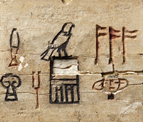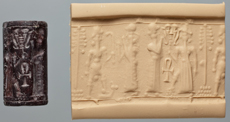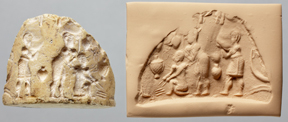Member's Preview: September 27, 2010
September 28, 2010 through March 6, 2011
Purchase the Exhibit Catalog.
Download the Exhibit Catalog.
Image Gallery
A new exhibition at the Institute for the Study of Ancient Cultures Museum at the University of Chicago will show visitors how scribes in the ancient Middle East invented writing, thus transforming prehistoric cultures into civilizations.
Writing is one of humankind's greatest achievements. Writing took a variety of forms, many of which are displayed in the exhibition, "Visible Language: Inventions of Writing in the Ancient Middle East and Beyond" that runs from September 28 to March 6 at the museum, 1155 East 58th Street.
Exhibit curator Christopher Woods, Associate Professor at the Institute for the Study of Ancient Cultures, said, "In the eyes of many, writing represents a defining quality of civilization. There are four instances and places in human history when writing was invented from scratch — in Mesopotamia, Egypt, China and Mesoamerica — without previous exposure to or knowledge of writing. It appears likely that all other writing systems evolved from the four systems we have in our exhibition."


Visitors will also learn the most recent theories about the origins of the alphabet. Long believed to have been invented in Phoenicia in about 1000 BC, the earliest alphabetic texts are now those found in the Sinai. This earliest alphabet was derived from Egyptian hieroglyphs as early as 1800 BC, well over five hundred years earlier than had been known. Examples of early alphabetic texts in Proto-Sinaitic, Old South Arabian, and Hebrew are included in the exhibit.
Institute for the Study of Ancient Cultures Director Gil Stein said, "Visitors to our exhibit will be able to compare the parallel pathways by which writing came into being. Seeing examples of early writing from these four areas together in one place, you can't fail to be impressed by the wonder of human creativity in these independent inventions that fundamentally transformed the very nature of civilization."
"It has been 25 years since we've had a comparable exhibit in the United States on the origins of writing, and our understanding and interpretation of the earliest writing has advanced considerably since then," added Geoff Emberling, Chief Curator of the Institute for the Study of Ancient Cultures Museum.

A computer kiosk will include videos and interactive presentations that enhance the exhibit. One video will show visitors how ancient scribes wrote cuneiform on clay tablets and painted hieroglyphs on papyrus.
Interactive presentations will show how Institute for the Study of Ancient Cultures scholars have been the first to use CT scans to reveal the contents of sealed clay "token balls" which are thought to be a precursor of Mesopotamian writing. Another interactive will demonstrate how the newest photographic techniques allow previously illegible texts to be read. Others will show how ancient cuneiform signs changed over time, and how early letters gradually evolved into the letters of our Latin alphabet.
A "Just for Fun" portion of the exhibition will help visitors compare writing systems and to write their name and simple sentences in various scripts. From the computer station, visitor will be able to send an e-post card in hieroglyphs or cuneiform to their friends.
A fully illustrated catalog edited by Professor Woods accompanies the exhibit.
The exhibit is supported by a grant from Exelon Corporation, the Women's Board of the University of Chicago, and private donors.

